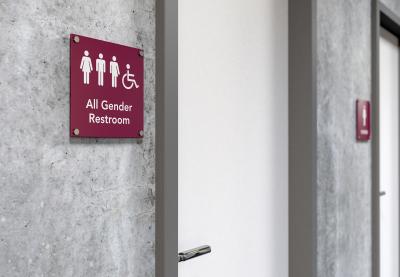Why Bathrooms Matter to Trans People
In the battle for trans rights, controversy often swells around which bathrooms trans students are allowed to use—potentially activating long-ranging trauma and fear for trans youth.
At first blush, restroom choice may seem like a minor issue in the march toward equality for trans youth. We know trans students are victims of harassment and bullying more than their cisgender peers. We know many are occupied with navigating the complications surrounding social or physical transition. Compared to these challenges, restroom or locker room access may seem like a small thing.
But when discrimination flares up in plain sight, when students are excluded or threatened or attacked for simply being who they are, the injustice is hard to ignore. For some students, however, the hurt may not make the news.
We may not see that hurt, but it happens nonetheless. It happens each time a trans student is mocked for using the locker room that aligns with their identity, each time they’re coldly informed they’re in the wrong bathroom, each time they exit a stall and are greeted by another exaggerated double take.
For trans students, the inescapable message is this: “You are different.” “You are unworthy.” “You do not belong here.”
Yet, educators occupy a powerful space. Trans students’ rights are under attack, and teachers and school staff have the authority to protect them. You can follow a few simple guidelines to affirm the rights and dignity of trans students at school.
How to Support Trans Students
Stay Current.
In the barrage of news media and constant change in the political climate, it is difficult to keep ahead of the latest updates in the bathroom access debate. Consider the refusal to be disoriented by the media muddle as a form of resistance. Arm yourself—and your students—with the facts.
Know Their Rights.
Trans students have the right to be treated according to their gender identity and to be called by the name and pronouns that match their gender identity. Additionally, they have the right not to be bullied or harassed because they are transgender or gender non-conforming, and they have the right to use the restroom or locker room that matches their gender identity.
Seek Out Truth.
If you have legal questions about how the Trump administration’s interpretation of Title IX and court nominations could affect the rights of trans students and school staff, find the answers from experts at the National Center for Transgender Equality, The Transgender Law Center, The National Center for Lesbian Rights or the Sylvia Rivera Law Project.
Learn the Laws.
Educate yourself about the many laws that protect trans students from discrimination at school. In humanities classes, have students research the origins and implications of Title IX, the First Amendment, FERPA, the Equal Access Act, and their local state laws and school district policies. Show your students the power in finding out the truth.
Trust and honor the experiences of trans youth.
This is the most important guideline of all. Respect trans students’ names and pronouns. Do not question their wishes, and explicitly communicate your support. As the courts continue to transform, they may need it more than ever.
To advocate for students and speak out for the rights they deserve, you can check your school policies against the law. It can take a little work to keep abreast of the increasing recognition of Title IX’s protection of trans students and to follow the progression of court cases, but understanding them will allow you to make the argument that advocates best for your students—whether they’re suffering from acute harassment and discrimination or bearing the brunt of daily microaggressions and all-too-commonplace transphobia.
This timeline can help you shore up your knowledge of court cases regarding transgender bathroom access and verify your understanding of the relevant legislation.
A Timeline of Trans Bathroom Access
March 2016
North Carolina’s legislature passes House Bill 2, banning trans youth from using the bathroom aligned with their gender identity and restricting their access to the facility corresponding with their gender assigned at birth.
May 2016
The Departments of Justice and Education state that discriminating against transgender students because of their gender identity violates Title IX. All schools receiving federal funding must treat gender identity as a protected category—just as they must do with sex and race.
May 2016
Officials from the Justice and Education Departments issue a memo to all school districts concerning discrimination in schools. The memo announces that, unless schools uphold the Obama administration’s trans-inclusive interpretation of Title IX, they risk being confronted with a lawsuit or loss of funding.
August 2016
Judge Reed O’Connor in Texas halts enforcement of the Obama administration’s directive for allowing transgender students to use the bathroom corresponding with their gender identity. The Trump administration later decides not to intervene.
February 2017
President Trump revokes the Obama-era interpretation of Title IX that protects transgender students from discrimination based on gender, putting the Trump administration at odds with several federal courts that have concluded that Title IX does protect trans students.
May 2018
A federal judge finds in favor of Gavin Grimm, a transgender student in Virginia who sued the school board for prohibiting him from using the boys’ restrooms. Gavin asserted that the school board’s insistence on his using bathrooms corresponding to his biological sex constituted sex discrimination and a violation of the law.
July 2018
Federal courts rule in favor of transgender students in two cases. In Florida, a U.S. District Court ruled that, by denying Drew Adams access to the boys’ room, a local school board had violated his right to equal protection of the law under the Constitution’s Fourteenth Amendment, as well as violating Title IX. The U.S. Court of Appeals upheld a Pennsylvania school district’s decision to implement a trans-inclusive restroom policy in the Doe v. Boyertown case.
Ehrenhalt is the school-based programming and grants manager with Teaching Tolerance.


0 COMMENTS